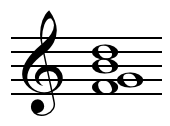Seventh (chord)
This article needs additional citations for verification. (February 2024) |


In
scale degrees above the root or tonal center.[1] When the seventh is the bass note, or lowest note, of the expressed chord, the chord is in third inversion ⓘ
.
Conventionally, the seventh is fourth in importance to the root,
minor or major
.
In jazz
In
"voice" this chord as G7. While in a strict classical music context, the notes of a G7 chord would be "G–B–D–F", in jazz, the fifth of the chord is often omitted. The root is also often omitted if playing in a jazz group, as it will usually be played by the bassist. Omitting the root and fifth gives the improvising
chord-playing musician the option to play other notes.
In voicing jazz chords, performers focus first on the seventh and the major or minor third of the chord, with the latter indicating the
altered dominant
chord in the key of C, built on a G would be to voice the chord as "B–C♯–E–F–A♭"; this would be G7 (b9,#11).
Types
The seventh note of a chord is most commonly a minor seventh (in C, B♭) or major seventh
enharmonic notes
).
Resolution
In the
dominant seventh chord, resolving to tonic, moves downward to the third
of the following chord. In the key of C major, the dominant seventh chord would be G7; the seventh note of this G7 chord is F, which should resolve downwards to an E in the next bar (typically supported by a C-major chord).
References
- ^ Riemann, Hugo. Dictionary of Music. Trans. J.A. Shedlock. Augener, 1900. 730.

